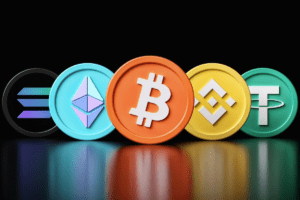Understanding Solana
To fully grasp the potential of Solana, it’s important to first understand what Solana is and its foundations in blockchain technology.
What is Solana?
Solana is a high-performance blockchain platform designed to provide fast, secure, and scalable solutions for decentralized applications (dApps) and cryptocurrencies. It aims to revolutionize the blockchain industry by addressing key challenges such as scalability, speed, and cost.
At its core, Solana employs a unique combination of cutting-edge technologies and innovative consensus mechanisms to achieve its goals. It uses a proof-of-history (PoH) consensus mechanism, which timestamps transactions before they are added to the blockchain. This enables high transaction throughput and eliminates the need for traditional consensus mechanisms that can slow down the network.
Solana’s architecture is built to scale horizontally, meaning it can handle increased network load by adding more validators and hardware resources. This scalability is crucial as it allows Solana to process thousands of transactions per second, making it well-suited for applications that require high-speed and low-cost transactions.
To learn more about the technical aspects of Solana, you can refer to the Solana whitepaper.
The Basics of Blockchain Technology
Blockchain technology forms the foundation of Solana and many other cryptocurrencies and decentralized platforms. It is a decentralized and distributed ledger system that securely records and verifies transactions across multiple computers or nodes.
The basic principles of blockchain technology involve the following key components:
-
Decentralization: Unlike traditional centralized systems, blockchain operates on a decentralized network. This means that no single entity has control over the entire network, making it more resistant to censorship and single points of failure.
-
Consensus Mechanism: Consensus mechanisms are algorithms used by blockchain networks to agree on the validity of transactions and ensure that all participants maintain a synchronized copy of the blockchain. Solana utilizes the proof-of-history (PoH) consensus mechanism, which incorporates a verifiable timestamp for each transaction.
-
Immutable Ledger: Once a transaction is recorded on the blockchain, it becomes immutable and tamper-proof. This provides a high level of security and transparency, as transactions cannot be altered or deleted without consensus from the network.
-
Smart Contracts: Smart contracts are self-executing contracts with predefined conditions encoded on the blockchain. They enable the automation of complex transactions and the creation of decentralized applications (dApps) on platforms like Solana.
By leveraging these fundamental principles, Solana aims to overcome the limitations of traditional blockchain platforms and deliver a high-performance infrastructure for the future of decentralized applications and cryptocurrencies.
As we delve deeper into Solana’s roadmap, we will explore its vision, key features, and the milestones it has achieved along the way. Stay tuned to discover how Solana is transforming the blockchain industry.
Exploring the Solana Roadmap
To understand the future direction of Solana, it’s important to explore its vision, mission, as well as the key features and innovations that set it apart in the blockchain space.
Solana’s Vision and Mission
Solana’s vision is to create a high-performance blockchain platform that can support widespread adoption of decentralized applications (dApps) and provide scalability for global financial systems. With a focus on speed, security, and decentralization, Solana aims to revolutionize the way blockchain technology is used.
Solana’s mission is to provide developers with a robust and user-friendly platform to build scalable applications, enabling them to unleash their creativity without being limited by the constraints of existing blockchain networks. By offering a scalable infrastructure, Solana aims to bridge the gap between the traditional financial world and the decentralized future.
Key Features and Innovations
Solana stands out among other blockchain platforms due to its unique features and innovations. Some of the key aspects that contribute to its capabilities include:
-
Scalability: Solana addresses one of the major challenges faced by blockchain networks by providing high throughput and low latency. Its unique architecture allows for parallel processing of transactions, enabling the network to handle thousands of transactions per second.
-
Proof of History (PoH): Solana incorporates a novel concept called Proof of History, which provides a historical record of all events on the blockchain. This enables efficient verification and synchronization of transactions, enhancing the overall security and performance of the network.
-
Smart Contracts: Solana supports the execution of smart contracts, allowing developers to build complex decentralized applications on the platform. By leveraging Solana’s high throughput and low latency, developers can create sophisticated applications that can handle large-scale transactions.
-
Tokenomics: Solana has its native token, which plays a vital role in the network’s governance, staking, and incentive mechanisms. The Solana token serves as a means of exchange, incentivizing validators and securing the network.
For a comprehensive understanding of Solana’s features and innovations, you can refer to the Solana whitepaper.
By following its roadmap, Solana aims to further enhance its capabilities, expand its ecosystem, and achieve widespread adoption in the blockchain industry. Let’s dive into the specific phases of Solana’s roadmap in the next section.
Solana’s Roadmap
To achieve its vision and mission, Solana has laid out a comprehensive roadmap consisting of several key phases. Each phase represents a significant milestone in the development and evolution of the Solana network. Let’s explore the roadmap of Solana, highlighting the key phases and their objectives.
Phase 1: Genesis
The Genesis phase marks the initial launch and establishment of the Solana network. During this phase, the foundational elements of Solana, such as the consensus mechanism and the core protocol, were developed and implemented. This phase focused on building a strong and secure foundation for the network to operate efficiently.
Phase 2: Building the Foundation
In the Building the Foundation phase, Solana aimed to enhance the network’s capabilities and expand its ecosystem. This phase involved the development of various tools and infrastructure to support developers in building decentralized applications (dApps) on the Solana platform. Additionally, efforts were made to foster a vibrant and inclusive community around Solana, encouraging collaboration and innovation.
Phase 3: Scaling the Network
Scaling the Network is a crucial phase for Solana, as it focuses on addressing one of the biggest challenges in blockchain technology: scalability. Solana aims to revolutionize blockchain scalability by introducing cutting-edge techniques and technologies. Through features like Proof of History (PoH) and the Solana architecture, the network aims to achieve high transaction throughput and low latency, making it suitable for a wide range of applications. To learn more about Solana’s scalability, you can refer to our article on Solana scalability.
Phase 4: Decentralization and Sustainability
The final phase of Solana’s roadmap is dedicated to achieving decentralization and long-term sustainability. Solana aims to decentralize the network by increasing the number of validators and encouraging participation from the community. This phase also focuses on ensuring the network’s sustainability by implementing mechanisms for governance, security, and economic stability. To learn more about Solana’s governance and staking, you can refer to our articles on Solana tokenomics and Solana staking.
By following this roadmap, Solana aims to create a robust and scalable blockchain platform that can support a wide range of applications and use cases. The roadmap reflects Solana’s commitment to continuous innovation and improvement, paving the way for a promising future. To stay updated on the latest developments and milestones achieved by Solana, keep an eye on their official channels and community updates.
Please note that the roadmap is subject to change as Solana adapts to new challenges and opportunities. For more detailed information about Solana’s roadmap and its technical aspects, you can refer to the Solana whitepaper.
In the next section, we will explore the notable achievements that Solana has already accomplished and discuss the future milestones and goals of this promising blockchain platform.
Milestones and Achievements
As Solana continues to make waves in the cryptocurrency and blockchain industry, it has achieved several notable milestones along its roadmap. These achievements highlight the platform’s progress and its commitment to revolutionizing blockchain technology.
Notable Achievements So Far
Solana has made significant strides since its inception, garnering attention and recognition for its innovative approach. Some of the notable achievements include:
-
High Throughput: Solana has demonstrated impressive scalability, achieving over 65,000 transactions per second (TPS) on its testnet. This high throughput capability positions Solana as one of the fastest blockchain networks in existence.
-
Fast Confirmation Times: Solana’s low-latency architecture enables fast confirmation times, with block times as low as 400 milliseconds. This ensures quick transaction finality, enhancing the user experience and enabling efficient decentralized applications (dApps).
-
Robust Infrastructure: Solana’s infrastructure is designed to handle a vast number of nodes and validators, ensuring the security and stability of the network. The platform has attracted a diverse range of validators, contributing to its decentralized nature.
-
Ecosystem Growth: Solana’s ecosystem has experienced remarkable growth, with a vibrant community and numerous partnerships. These collaborations span various sectors and aim to leverage Solana’s capabilities to develop innovative solutions.
Future Milestones and Goals
Looking ahead, Solana has an ambitious roadmap that outlines its future milestones and goals. The platform continues to prioritize scalability, decentralization, and sustainability. Some key milestones and goals include:
-
Phase 1: Genesis: The initial phase focuses on building the foundation for the Solana network, establishing key features and infrastructure.
-
Phase 2: Building the Foundation: In this phase, Solana aims to enhance its core technology and expand its ecosystem through partnerships and developer support.
-
Phase 3: Scaling the Network: Solana is committed to further improving its scalability, aiming to handle even higher transaction volumes while maintaining fast confirmation times.
-
Phase 4: Decentralization and Sustainability: Solana’s final phase aims to achieve complete decentralization, ensuring the network’s long-term sustainability and resilience.
Solana’s future milestones and goals reflect its dedication to continuous innovation and growth. By pushing the boundaries of blockchain technology, Solana seeks to unlock new potential use cases and applications. To learn more about Solana’s technology and token economics, refer to our article on Solana tokenomics.
As Solana progresses along its roadmap, it will continue to shape the cryptocurrency and blockchain industry, providing a robust and scalable platform for decentralized applications and financial innovations.
The Promising Future of Solana
As Solana continues to make waves in the cryptocurrency and blockchain industry, its future looks incredibly promising. With its innovative technology and ambitious roadmap, Solana is poised to revolutionize various sectors. Let’s explore the potential applications and use cases of Solana, as well as its impact on the cryptocurrency and blockchain industry.
Potential Applications and Use Cases
Solana’s high-speed, scalable, and secure blockchain platform opens up a vast array of potential applications and use cases. Here are a few areas where Solana’s technology is expected to have a significant impact:
-
Decentralized Finance (DeFi): Solana’s fast transaction processing speed and low fees make it an ideal platform for various DeFi applications such as decentralized exchanges, lending and borrowing platforms, and stablecoins. Its scalability allows for seamless execution of complex financial transactions.
-
Decentralized Applications (DApps): Solana provides an excellent platform for building and deploying decentralized applications. Its scalability and high throughput enable DApps to handle a large number of users and transactions without sacrificing performance.
-
Tokenization and Asset Management: Solana’s blockchain can facilitate the tokenization of real-world assets, such as real estate or artwork, enabling fractional ownership and enhancing liquidity. This opens up opportunities for efficient asset management and increased accessibility to traditionally illiquid assets.
-
Supply Chain Management: Solana’s transparent and immutable ledger can be leveraged to create more efficient and secure supply chain management systems. By utilizing smart contracts, companies can track and verify every step of the supply chain, ensuring authenticity, transparency, and minimizing fraud.
Impact on the Cryptocurrency and Blockchain Industry
Solana’s innovative technology and ambitious roadmap have the potential to significantly impact the cryptocurrency and blockchain industry in several ways:
-
Scalability: Solana’s focus on scalability addresses one of the major limitations of many blockchain networks. By offering high throughput and low latency, Solana can handle a massive number of transactions, making it a strong contender in the race for scalable blockchain solutions.
-
Improved User Experience: With its fast transaction confirmation times and low fees, Solana aims to provide a seamless user experience, making it more accessible to a wider range of users. This enhanced user experience could drive greater adoption of blockchain technology.
-
Competition and Innovation: Solana’s innovative approach to blockchain technology encourages healthy competition in the industry. Its unique consensus algorithm, Proof of History (PoH), and other features push the boundaries of what is possible, inspiring other projects to innovate and improve their own technologies.
-
Ecosystem Development: Solana’s growth and success attract developers, entrepreneurs, and investors, fostering the development of a vibrant ecosystem. This ecosystem includes partnerships with various projects, collaborations with leading organizations, and an active community that contributes to the ongoing development and adoption of Solana.
As Solana continues to execute its roadmap and achieve important milestones, it is expected to solidify its position as a key player in the cryptocurrency and blockchain industry. Its potential applications, impact on scalability, and contributions to innovation make it an exciting project to watch.
To delve deeper into Solana’s roadmap and its impact on the industry, be sure to explore the Solana whitepaper and stay updated with the latest developments in the Solana ecosystem.



